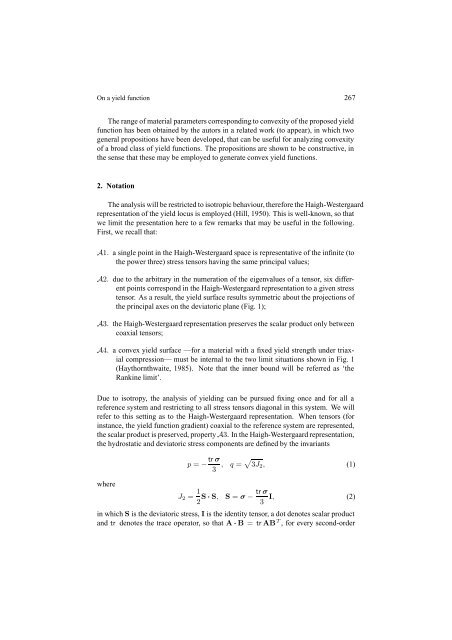A new yield function for geomaterials. - Ingegneria - Università degli ...
A new yield function for geomaterials. - Ingegneria - Università degli ...
A new yield function for geomaterials. - Ingegneria - Università degli ...
Create successful ePaper yourself
Turn your PDF publications into a flip-book with our unique Google optimized e-Paper software.
On a <strong>yield</strong> <strong>function</strong> 267<br />
The range of material parameters corresponding to convexity of the proposed <strong>yield</strong><br />
<strong>function</strong> has been obtained by the autors in a related work (to appear), in which two<br />
general propositions have been developed, that can be useful <strong>for</strong> analyzing convexity<br />
of a broad class of <strong>yield</strong> <strong>function</strong>s. The propositions are shown to be constructive, in<br />
the sense that these may be employed to generate convex <strong>yield</strong> <strong>function</strong>s.<br />
2. Notation<br />
The analysis will be restricted to isotropic behaviour, there<strong>for</strong>e the Haigh-Westergaard<br />
representation of the <strong>yield</strong> locus is employed (Hill, 1950). This is well-known, so that<br />
we limit the presentation here to a few remarks that may be useful in the following.<br />
First, we recall that:<br />
A1. a single point in the Haigh-Westergaard space is representative of the infinite (to<br />
the power three) stress tensors having the same principal values;<br />
A2. due to the arbitrary in the numeration of the eigenvalues of a tensor, six different<br />
points correspond in the Haigh-Westergaard representation to a given stress<br />
tensor. As a result, the <strong>yield</strong> surface results symmetric about the projections of<br />
the principal axes on the deviatoric plane (Fig. 1);<br />
A3. the Haigh-Westergaard representation preserves the scalar product only between<br />
coaxial tensors;<br />
A4. a convex <strong>yield</strong> surface —<strong>for</strong> a material with a fixed <strong>yield</strong> strength under triaxial<br />
compression— must be internal to the two limit situations shown in Fig. 1<br />
(Haythornthwaite, 1985). Note that the inner bound will be referred as ‘the<br />
Rankine limit’.<br />
Due to isotropy, the analysis of <strong>yield</strong>ing can be pursued fixing once and <strong>for</strong> all a<br />
reference system and restricting to all stress tensors diagonal in this system. We will<br />
refer to this setting as to the Haigh-Westergaard representation. When tensors (<strong>for</strong><br />
instance, the <strong>yield</strong> <strong>function</strong> gradient) coaxial to the reference system are represented,<br />
the scalar product is preserved, property A3. In the Haigh-Westergaard representation,<br />
the hydrostatic and deviatoric stress components are defined by the invariants<br />
tr σ<br />
p = −<br />
3 , q = 3J2, (1)<br />
where<br />
J2 = 1<br />
tr σ<br />
S · S, S = σ − I, (2)<br />
2 3<br />
in which S is the deviatoric stress, I is the identity tensor, a dot denotes scalar product<br />
and tr denotes the trace operator, so that A · B = tr ABT , <strong>for</strong> every second-order
















